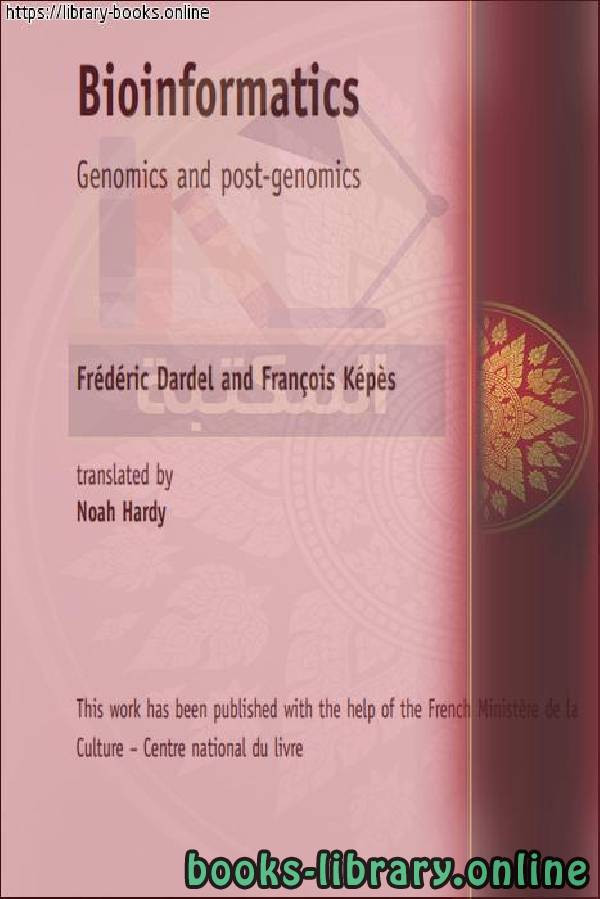📘 قراءة كتاب Bioinformatics Genomics and Post-Genomics أونلاين


Biologically
Biology is a natural science that is concerned with the study of life, its various forms and its function, how these organisms interact with each other and with the surrounding environment. The word biology in Greek is made up of two words: bio (βίος) meaning life. And loggia (-λογία) means science or study. Biology: the similarity of vegetation and animal cover on the edges of the African and American states, and the existence of the same fossil.
Branches of biology
Biology is an ancient science thousands of years old and modern biology began in the nineteenth century. This science has multiple branches. Among them are:
Anatomy
Botany
Biochemia
Biogeography
Biofisia
Cytology or cell science
Ecology or environmental science
نبذه عن الكتاب:
The dideoxyribonucleotide method, developed during the early 1980s in
England, at the Cambridge University laboratory of Fred Sanger, is today universally employed to sequence DNA fragments. It is based on the use of DNA
polymerase to elongate a single strand of DNA, starting from a primer, utilizing another DNA strand as the template. The DNA polymerase elongates the
strand in the presence of four deoxyribonucleotide monomers (dATP, dTTP,
dGTP, and dCTP) and a dideoxyribonucleotide analog (ddNTP), which acts as
the chain terminator (Figure 1.1). Specific incorporation of the analog by DNA
polymerase yields a mixture of fragments that selectively terminate at positions
corresponding to each nucleotide (As, in the example below).
The principle of the dideoxyribonucleotide (‘dideoxy’) method is illustrated
in Figure 1.2. Four parallel reactions are carried out, one with each ddNTP, the
DNA fragments obtained being separated by electrophoresis. A fluorescent
tracer is used to identify fragments synthesized by the polymerase so as to distinguish them from template DNA. The tracer is attached to one extremity of
the fragment, either at the 5′-end of the sequencing primer or at the 3′-end of
the dideoxynucleotide terminator. Modern automatic sequencers utilize an in
situ detection system during electrophoresis, in which a laser beam emitting in
the fluorophore absorption spectrum is passed through the gel (Figure 1.3). A
migrating DNA fragment in the path of the laser beam then emits a fluorescent
signal detected by a photodiode on the other side of the gel. The signal is amplified and transmitted to a computer programmed with special software for
analyzing it.
Biology
Human biology
Who is the founder of biology?
The importance of biology
Areas of work in the field of biology
Theories of biology
Research on biology for the first grade of secondary school
Human biology
سنة النشر : 2006م / 1427هـ .
حجم الكتاب عند التحميل : 3.97 .
نوع الكتاب : pdf.
عداد القراءة:
اذا اعجبك الكتاب فضلاً اضغط على أعجبني و يمكنك تحميله من هنا:

شكرًا لمساهمتكم
شكراً لمساهمتكم معنا في الإرتقاء بمستوى المكتبة ، يمكنكم االتبليغ عن اخطاء او سوء اختيار للكتب وتصنيفها ومحتواها ، أو كتاب يُمنع نشره ، او محمي بحقوق طبع ونشر ، فضلاً قم بالتبليغ عن الكتاب المُخالف:
 قبل تحميل الكتاب ..
قبل تحميل الكتاب ..
يجب ان يتوفر لديكم برنامج تشغيل وقراءة ملفات pdf
يمكن تحميلة من هنا 'http://get.adobe.com/reader/'


 منصّة المكتبة
منصّة المكتبة 